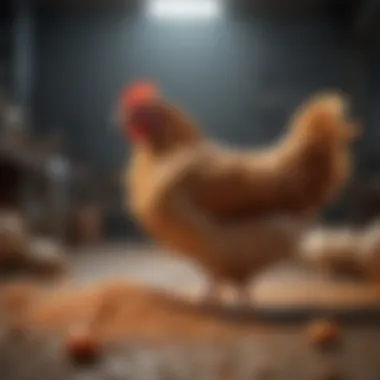Understanding Small Chicken Feed: A Comprehensive Guide


Intro
In the realm of poultry care, understanding the nuances of small chicken feed is pivotal. Many chicken owners overlook the significance of feed quality and composition. Instead, they may assume that any feed will suffice. However, selecting the right chicken feed has far-reaching implications for the health, growth, and productivity of these birds.
This guide aims to provide thorough insights into chicken feed, addressing its components, nutritional values, and practical applications. By exploring the varieties of feed, the implications for different chicken breeds, and the role of feed formulations, this document seeks to enhance your knowledge and equip you with effective strategies for optimizing chicken health and egg production.
An informed approach to chicken nutrition can lead to improved flock performance, better egg quality, and overall well-being. It also dispels common misconceptions surrounding chicken care. Let us begin by examining the specifics of chicken nutrition and the many elements that contribute to a healthy diet.
Key Components of Chicken Feed
Chicken feed generally consists of various ingredients, each contributing essential nutrients. Understanding the key components can empower owners to make informed choices.
- Grains: Commonly used grains include corn and wheat. They provide energy through carbohydrates.
- Protein Sources: Soybean meal is a primary source of protein. It supports muscle development and egg production.
- Fats: Adding fat, like vegetable oil, can enhance energy content, particularly during colder months.
- Vitamins and Minerals: Essential nutrients such as calcium, phosphorus, vitamin D, and selenium contribute to strong bones and reproductive health.
Proper nutrition is crucial for maintaining chicken health. Each feed type is formulated to meet the specific needs of various breeds.
Nutritional Values and Importance
Nutritional values differ based on the age and purpose of the chickens. Chickens raised for meat (broilers) require a higher caloric intake compared to layers, which need more calcium for eggshell formation.
- Starter Feed: Recommended for chicks, it is high in proteins (around 20-24%).
- Grower Feed: Ideal for young birds, it offers balanced nutrition to support growth, usually 16-20% proteins.
- Layer Feed: Contains higher calcium levels, essential for laying hens, and typically contains 16-18% proteins.
Selecting the right feed according to the birds' growth stages is vital to optimizing health and production.
Feeding Strategies
Implementing effective feeding strategies further enhances the benefits of a proper diet.
- Free-Feeding: Allows chickens to eat as they please, which can be beneficial for some owners.
- Controlled Feeding: Involves offering specific amounts of feed at set times, which can help manage weight and prevent waste.
- Supplemental Feeding: Additional snacks like kitchen scraps or grains can provide variety and improve overall satisfaction with diets.
By adjusting feeding strategies to match the birds' needs, owners can maximize production and maintain optimal health.
Common Misconceptions
Misunderstandings surrounding chicken nutrition can lead to inadequate care. For instance, some owners believe that feeding chickens kitchen scraps is enough, when in fact it may lack essential nutrients. Additionally, many think that commercial feed is not necessary if free-ranging is available. However, free-ranging does not always supply balanced nutrition, especially in urban environments.
Engaging with credible sources, such as academic articles or veterinary guidance, can provide clarity. Educating oneself about the complexities of chicken feed allows for better decision-making and joyful poultry keeping.
Preface to Small Chicken Feed
Understanding the realm of small chicken feed is essential for all poultry owners. Chickens require a balanced diet to thrive, and feed plays a crucial role in achieving optimal health and productivity. The right feed not only supports their growth but also enhances egg production for layers and meat yield for broilers. Furthermore, various chicken breeds may demand specific nutritional needs, making it vital to choose appropriate feed formulations.
Small chicken feed consists of numerous ingredients, each serving distinct nutritional purposes. A compelling aspect of feed is how it can cater to different life stages and specific functions. For instance, in the early days, chicks need different nourishment compared to grown layers or broilers. This illustrates the importance of type and formulation within small chicken feed.
In addition to promoting growth and production, the right diet can significantly impact a chicken's overall well-being. Quality feed can prevent various health issues and improve the longevity of your flock. Therefore, knowledge about small chicken feed is not merely academic; it leads to informed decisions that can enhance the quality of life for your chickens.
Education on feed selections is also relevant in the context of evolving agricultural practices. As more people embrace backyard poultry-keeping, it becomes increasingly important to disseminate accurate information about nutritional requirements and optimal feeding strategies. This guide seeks to bridge any gaps in understanding and clear misconceptions around chicken feed.
By exploring the nutritional components, types of feed available, and their impact on chicken health, we strive to provide a comprehensive resource for both novice and seasoned poultry-keepers. This will ensure that choices are grounded in a sound understanding of chicken nutrition and welfare.
"A well-informed chicken owner can not only improve the health of their birds, but can also ensure greater productivity."
Thus, this article aims to equip pet owners and poultry enthusiasts with the necessary insights to make educated choices concerning small chicken feed.
Nutritional Components of Chicken Feed
In the realm of poultry care, an understanding of the nutritional components of chicken feed is crucial. Proper nutrition directly affects the health and productivity of chickens. The components of feed offer essential nutrients that support growth, egg production, and overall well-being. Recognizing these elements helps in selecting the right feed for different breeds and purposes. This section focuses on macronutrients and micronutrients, both of which play vital roles in the health and development of chickens.
Macronutrients in Chicken Feed
Macronutrients are the primary building blocks of chicken feed. They consist of proteins, carbohydrates, and fats, each serving a unique purpose in poultry nutrition.
Proteins
Proteins are essential for growth and development in chickens. They are the primary source of amino acids, which are vital for building muscle and tissues. Quality protein sources include soybean meal and fish meal. The key characteristic of proteins in chicken feed lies in their amino acid profile. A good balance of essential amino acids improves weight gain and egg production.


However, not all protein sources are equal, and some may contain anti-nutritional factors. It is important to choose high-quality protein to avoid health issues in chickens.
Carbohydrates
Carbohydrates provide energy, which is critical for daily functions and growth. They are mainly sourced from grains like corn and wheat. Their key characteristic is their ability to supply quick energy, making them a staple in many chicken feeds.
An important feature of carbohydrates is their digestibility. A high digestibility rate enhances energy availability, ensuring chickens remain active. A disadvantage is that excessive carbohydrates without adequate protein can lead to obesity and related health issues.
Fats
Fats are another crucial macronutrient, offering a concentrated source of energy. They not only supply energy but also play a role in nutrient absorption. Sources like vegetable oils provide essential fatty acids, promoting overall health.
The key characteristic of fats is their high energy density. This makes them beneficial for rapidly growing chicks or layers in high production phases. However, the unique feature of fats is that while they are energy-rich, over-supplying fats can lead to health problems like fatty liver disease.
Micronutrients Essential for Growth
Micronutrients, though required in smaller quantities, are vital for health and development. They include vitamins, minerals, and amino acids.
Vitamins
Vitamins are critical for metabolic functions within the body. Each vitamin serves specific roles, such as enhancing immune function or supporting growth. Fat-soluble vitamins like A, D, E, and K are crucial in fostering health and productivity.
The advantage of including vitamins in chicken feed is their ability to prevent deficiencies that could hinder health. However, an imbalance can lead to toxicity, underscoring the need for careful formulation of feeds.
Minerals
Minerals support various physiological functions, including bone development and enzyme activities. Key minerals include calcium, phosphorus, and sodium. The primary characteristic of minerals is their role in forming bones and eggs, making them essential for layer hens.
Careful attention must be given to mineral content, as deficiencies affect bone strength and can lead to reproductive issues. Conversely, too much can also create health complications.
Ammino Acids
Amino acids are the building blocks of proteins. Their presence in chicken feed is vital for muscle growth, feather development, and overall health. Essential amino acids must be included because they cannot be synthesized by chickens.
The unique aspect of amino acids is how they directly impact growth performance. Supplementing with the right amino acids can significantly enhance feed efficiency. However, focusing too heavily on a few amino acids can lead to imbalances that affect overall nutrition.
Types of Small Chicken Feed
Understanding the types of small chicken feed is crucial for anyone raising chickens. The feed you choose greatly impacts the hen's overall health, growth, and productivity. This section outlines the most common feed types, their specific purposes, and the benefits of each. Choosing the right feed is not just about convenience; it holds significance for the development and well-being of your flock.
Starter Feed: For Growing Chicks
Starter feed is specifically formulated for young chicks, typically from hatching to about six weeks of age. This feed is higher in protein and energy compared to other types. The elevated protein content supports rapid growth and organ development, which is critical during this early life stage. Essential vitamins and minerals are also included, ensuring that chicks receive a balanced diet necessary for their developing bodies.
When selecting starter feed, look for formulations that emphasize digestibility. Young chicks' digestive systems are sensitive. Using finely ground grains allows them to better absorb nutrients.
Grower Feed: Supporting Development
Once chicks reach six weeks old, they transition to grower feed. This type of feed is designed to support continued development until they are about 14 weeks old. The protein content becomes slightly lower than starter feed but still remains substantial. The focus shifts to maintaining a balanced nutrition that helps develop bones and muscles, which are important for their growth trajectory.
Grower feed usually contains a variety of grains, protein meals, and vitamins appropriate for this life stage. It's essential to monitor the chickens' growth patterns and adjust the feed as needed in this developmental phase.
Layer Feed: Enhancing Egg Production
Layer feed becomes crucial when hens start laying eggs, usually around 18 weeks of age. This type of feed is specially formulated to support egg production and improve the quality of eggs produced. Layer feed has a higher calcium content, essential for creating strong eggshells. Additionally, protein levels are adjusted to meet the needs of actively laying hens.
A good layer feed will consist of grains, protein sources, and appropriate supplements. Monitor the hens for any signs of stress or nutritional deficiency and adjust their feed accordingly.
Broiler Feed: For Meat Production
Broiler feed is tailored for chickens raised specifically for meat production. This type of feed approximately offers a balance of protein, energy, and other nutrients that support fast growth. Broilers are typically raised for a few weeks to reach market weight quickly, hence the specific nutritional requirements of broiler feed.
Different formulations may be available based on the target weight for the chickens. High-quality broiler feed should support good feed conversion ratios, ensuring that the chickens grow efficiently without unnecessary weight gain.
Ultimately, choosing the appropriate feed type is fundamental for optimal chicken health, growth, and productivity. Ensuring that chickens receive the correct nutrition at each stage will pay dividends in the long run.


Understanding Feeding Strategies
Feeding strategies play a crucial role in the overall health and productivity of chickens. Understanding how different feeding methods can impact the growth and well-being of your flock is essential for any poultry enthusiast. Making informed decisions about feeding strategies can lead to improved nutrient absorption, enhanced growth rates, and better egg production. The right approach to feeding ensures chickens receive adequate nutrition while minimizing waste.
Free-Choice Feeding Versus Scheduled Feeding
Free-choice feeding allows chickens to access food at any time. This method can be beneficial for certain breeds, as it promotes natural foraging behavior. Chickens are more likely to eat when they need it, which can lead to healthier birds. However, there are also drawbacks to this approach, mainly regarding potential overconsumption. Chickens might eat excessive amounts of feed, leading to obesity and other health issues.
On the other hand, scheduled feeding provides food to the chickens at specific times. This method helps control portion sizes and prevents overeating. It can be particularly beneficial for growing chicks and layers. Scheduled feeding allows you to monitor intake more easily, ensuring that each bird gets the right amount of nutrients.
It's essential to consider the unique needs of your flock before deciding on a feeding strategy. Each method has its advantages and disadvantages, and the best choice may depend on factors such as the age of the chickens, their purpose (e.g., egg-layers or meat production), and the type of feed used.
Importance of Feed Ratio
Feed ratio refers to the proportion of different feed types provided to chickens. This is a critical factor in formulating a balanced diet that meets the nutritional needs of your flock. The right feed ratio ensures an optimal balance of macronutrients and micronutrients. Understanding how to calculate and implement this can significantly impact overall health.
A well-defined feed ratio can prevent nutritional deficiencies and help maintain the growth rates you desire. For instance, adjusting protein levels in the feed can support the growth of chicks or boost egg production in layers. In contrast, improper feed ratios can lead to muscle growth imbalances and various health problems.
Keeping a close eye on your birds will also inform adjustments in feed ratios. Regularly assess their body condition, productivity, and behavior. Changes in these factors can indicate whether the current feed ratio is adequate or needs adjustment. Always keep records of feed types and ratios used, making it easier to evaluate changes over time and their impacts on your flock.
Impact of Feed Quality on Chicken Health
The quality of chicken feed has a direct impact on the health and productivity of chickens. Feeding chickens high-quality feed is essential for ensuring proper growth, egg production, and overall well-being. The nutritional value of the feed influences not only the health of individual birds but also the productivity of the flock. Therefore, it is crucial for pet owners and poultry enthusiasts to understand the significance of selecting appropriate feed.
Poor feed quality can lead to deficiencies in vital nutrients. This can result in various health issues, including poor growth rates, weakened immune systems, and reduced egg production. Understanding how to identify quality feed is paramount for effective poultry management. The next subsection will provide insights into recognizing high-quality feed that meets the needs of chickens.
Identifying Quality Feed
To choose the right feed, one must look at several factors. First, check the ingredients listed on the feed bag. A high-quality feed typically contains natural ingredients such as grains, seeds, and protein sources. Avoid products with artificial additives or low-quality fillers. The balance of macronutrients is also key. Look for feed with the right levels of protein, carbohydrates, and fats suitable for the specific type of chicken.
Additionally, it is important to verify that the feed is fresh. Expired feed can lose nutritional value, making it less effective. When buying feed, check for proper storage conditions. A feed that is stored in a dry, cool place will usually retain its quality better than feed exposed to moisture or pests.
Consequences of Poor Nutritional Choices
Opting for poor-quality feed can have severe consequences. Chickens fed inadequate nutrition may display reduced growth rates and lower egg production. Furthermore, long-term poor nutrition can lead to metabolic disorders and susceptibility to diseases. Chickens might also develop behavioral issues, such as feather pecking, due to nutritional deficiencies.
These health problems not only affect the chickens themselves but can also impact the entire flock. For those who keep chickens for eggs or meat, the economic implications are significant. Hence, ensuring quality feed is critical for avoiding these negative outcomes.
Ultimately, understanding the importance of feed quality is crucial for any owner of chickens. By knowledgeably selecting high-quality feed, one can support the health and productivity of their flock, ensuring a sustainable and profitable chicken-rearing experience.
"The health of your flock demonstrates the importance of quality nutrition in poultry management. A well-nourished chicken leads to better production outcomes."
For further information on poultry nutrition, you may visit Wikipedia or Britannica.
Common Myths About Chicken Feed
Understanding the misconceptions surrounding chicken feed is crucial for anyone involved in poultry care. Many pet owners and poultry enthusiasts might believe inaccurate information, leading to poor feeding practices. Identifying these myths is important because it ultimately affects chicken health, egg production, and the overall welfare of the birds. Misunderstandings can also result in significant monetary waste on improper feed ingredients, which do not contribute positively to the chickens’ diet. Here are two prevalent misconceptions and their underlying truths that every chicken keeper should know.
Myth: Chickens Can Eat Anything
One of the most pervasive myths is that chickens can eat any type of food without consequence. This belief is misleading and can have negative health implications. While chickens are omnivorous and can enjoy a variety of foods, not all items are suitable. Some common human foods can be harmful, including:
- Chocolate: Contains caffeine and theobromine, both of which are toxic to poultry.
- Onions: Can lead to hemolytic anemia, affecting red blood cells.
- Avocado: Contains persin, a compound that is harmful to birds.
It's essential for bird owners to realize that while chickens may actively seek out diverse food sources, offering inappropriate items can lead to health issues or even fatalities. A balanced diet comprising layer pellets or crumbles, grains, and fresh vegetables is critical for optimal growth and egg production.
"Choosing the right feed lays the foundation for healthy chickens; mistakes can jeopardize their wellbeing."
Myth: All commercial feeds are the same
Another common misconception is that all commercial chicken feeds on the market are identical. This couldn’t be further from the truth. The composition of chicken feed varies significantly based on its purpose, ingredients, and nutrient content. Factors to consider here include:
- Type of Feed: Starter, grower, layer, and broiler feeds are formulated differently to address specific nutritional needs at various life stages.
- Ingredient Quality: Some brands prioritize high-quality ingredients, while others may rely on by-products with less nutritional value.
- Additives and Supplements: Certain feeds come with probiotics or vitamins, enhancing gastrointestinal health and overall vitality.
Selecting the right feed requires careful attention to label information and an understanding of unique dietary needs. It is unwise to assume that a lower-priced option will suffice. Instead, owners should research and choose reputable brands, ensuring optimal nutrition for their chickens.


In summary, debunking these myths encourages better feeding practices. By recognizing that chickens need a specialized diet rather than a free-for-all approach, and understanding that not all feeds are created equal, poultry enthusiasts can significantly enhance the health and productivity of their birds.
Homemade Chicken Feed: Pros and Cons
Making homemade chicken feed can be appealing for many poultry owners. It offers a measure of control over ingredients, allowing owners to cater to specific nutritional needs of their chickens. Understanding the benefits and drawbacks of DIY feed recipes can assist in making informed choices for the health of your flock.
Benefits of DIY Feed Recipes
- Customization: One of the primary advantages of homemade chicken feed is the ability to customize the blend to meet your flock’s specific needs. For example, if you have chickens that require more protein, you can include ingredients such as soybean meal or fish meal to achieve this goal.
- Quality Control: When you make your own feed, you have complete control over the quality of the ingredients. This is particularly important if you can source organic or non-GMO materials. By knowing where the ingredients come from, you can ensure that it meets your standards and your chickens' dietary requirements.
- Cost-Effective: In some cases, producing your own feed may be less expensive than purchasing commercial options. By buying ingredients in bulk and preparing feed at home, you can potentially reduce costs, especially if you have access to local farming products.
- Freshness: Homemade feed can be fresher than store-bought varieties. Fresh feed can lead to better palatability and nutrition. Chickens often prefer food that is recently prepared rather than something that has been stored for extended periods.
Drawbacks and Risks
- Nutritional Imbalance: A significant risk associated with homemade chicken feed is the potential for nutritional imbalance. Without a solid understanding of poultry nutrition, it’s easy to miss essential nutrients. Chickens require a careful balance of vitamins, minerals, fats, and proteins to thrive. Insufficient knowledge can lead to deficiencies that may affect growth and egg production.
- Time and Effort: Preparing homemade feed involves considerable time and effort. It requires research, planning, and regular preparation. For busy individuals, the commitment might become overwhelming, making commercial feeds a more practical choice.
- Ingredient Sourcing: While sourcing high-quality ingredients is beneficial, it can also be a challenge. Not all ingredients necessary for a balanced diet may be readily accessible, especially in certain regions. Furthermore, some locally sourced products may not have consistent quality, which could affect the nutritional value of the feed.
- Potential Allergens: Just as with any diet, some chickens may have allergies or sensitivities to specific ingredients. This could lead to health problems or behavioral issues. Keeping track of how each chicken reacts to homemade feed can add an additional layer of complexity.
Homemade chicken feed can empower owners but must be approached with care, knowledge, and preparation.
Monitoring Chicken Behavior and Health
Monitoring chicken behavior and health is critical for any poultry owner. Chickens cannot verbally express their needs or discomforts, making it essential to observe their actions closely. Doing so helps in identifying issues early, ensuring the flock remains healthy and productive.
Signs of Nutritional Deficiency
Nutritional deficiencies in chickens often manifest through various visible signs. Understanding these signs is vital for maintaining the health of the flock. Common indicators include:
- Decreased Egg Production: One of the first signs of nutritional issues is a drop in the number of eggs laid. Chickens require specific nutrients to maintain ovulation.
- Poor Feather Condition: When chickens do not receive adequate protein, their feathers may lose luster or show signs of feather pecking.
- Weight Loss or Poor Body Condition: Healthy chickens should have a sufficient body weight. If they appear thin or lethargic, it may signal nutritional inadequacy.
- Behavioral Changes: Chickens that are not feeling well may become less active or isolate themselves from the flock.
Regular assessment of their feed and behavior facilitates early identification of these signs. Incorporating a varied diet can also help prevent deficiencies from arising in the first place.
Behavioral Changes Linked to Feed
The feed you provide can significantly influence the behavioral patterns of chickens. Changes in feed quality or composition can disrupt their regular behavior. Observing these changes allows for timely interventions. Common behavioral changes include:
- Aggression or Pecking Order Disruption: An unbalanced diet may lead to increased aggression among chickens. Territorial disputes can become more common, disrupting the social structure.
- Increased Foraging Behavior: If chickens are not getting enough nutrition from their feed, they may start foraging more actively, which can lead to undesirable habits or potential health risks.
- Lethargy: Chickens lacking in essential nutrients can exhibit signs of tiredness. They may sit down frequently or avoid participating in standard flock activities.
Regular monitoring of chicken behavior not only helps in identifying issues with feed but also aids in preventing larger health problems, ensuring the overall well-being of the flock.
Finale: Best Practices for Feeding Chickens
Feeding chickens is not just about giving them food. It is an essential component that affects their overall health, productivity, and well-being. This guide extensively covers various aspects of chicken feed. Now, let’s synthesize the information presented, focusing on best practices.
Understanding Nutritional Balance
First, it is crucial to understand the nutritional balance required for chickens. Each life stage demands specific nutritional needs.
- Chicks require high protein for growth.
- Layers need adequate Calcium for strong eggshells.
- Broilers should have higher energy levels to promote heavier weight.
Failing to provide these will lead to deficiencies, impacting health and productivity.
Selecting Appropriate Feed
Choosing the right feed brand is vital. Not all feeds are created equal.
- Research and select feeds that meet the nutritional regimen.
- Check labels for guaranteed analyses of vitamins and minerals.
- Opt for local or reputable brands with verified quality.
By understanding what goes into feed, you can make more informed choices.
Monitoring Feed and Health
Regularly monitor how much your chickens eat. This helps identify any potential issues early. Changes in feeding behavior can signal health problems. Be observant. Changes in weight or feather condition may hint at nutritional deficiencies.
- Daily checks are advisable for healthy flock management.
- Consult with avian vet experts for tailored advice on feed quality and potential nutritional needs.
Implementation of Feeding Strategies
Decide on a feeding strategy that suits your flock's needs.
- Free-choice feeding allows birds to self-regulate. However, it may lead to waste.
- Scheduled feeding can optimize feed usage and ensures that all chickens receive appropriate amounts at set times.
Choose methods based on your specific situation. Both methods have their pros and cons, yet aligning them with your flock's behavior is essential.
Final Thought
To sum it up, best practices for feeding chickens involve understanding nutritional needs, selecting appropriate feeds, monitoring health indicators, and implementing effective feeding strategies. By following these principles, poultry owners can ensure healthy living conditions and optimize the productivity of their chickens. Your responsibility to your flock is substantial. Thus, well-informed decisions are paramount for successful chicken husbandry.







